Fuzhen Zhuang
Hyperbolic Diffusion Recommender Model
Apr 02, 2025Abstract:Diffusion models (DMs) have emerged as the new state-of-the-art family of deep generative models. To gain deeper insights into the limitations of diffusion models in recommender systems, we investigate the fundamental structural disparities between images and items. Consequently, items often exhibit distinct anisotropic and directional structures that are less prevalent in images. However, the traditional forward diffusion process continuously adds isotropic Gaussian noise, causing anisotropic signals to degrade into noise, which impairs the semantically meaningful representations in recommender systems. Inspired by the advancements in hyperbolic spaces, we propose a novel \textit{\textbf{H}yperbolic} \textit{\textbf{D}iffusion} \textit{\textbf{R}ecommender} \textit{\textbf{M}odel} (named HDRM). Unlike existing directional diffusion methods based on Euclidean space, the intrinsic non-Euclidean structure of hyperbolic space makes it particularly well-adapted for handling anisotropic diffusion processes. In particular, we begin by formulating concepts to characterize latent directed diffusion processes within a geometrically grounded hyperbolic space. Subsequently, we propose a novel hyperbolic latent diffusion process specifically tailored for users and items. Drawing upon the natural geometric attributes of hyperbolic spaces, we impose structural restrictions on the space to enhance hyperbolic diffusion propagation, thereby ensuring the preservation of the intrinsic topology of user-item graphs. Extensive experiments on three benchmark datasets demonstrate the effectiveness of HDRM.
Bridging Social Psychology and LLM Reasoning: Conflict-Aware Meta-Review Generation via Cognitive Alignment
Mar 21, 2025Abstract:The rapid growth of scholarly submissions has overwhelmed traditional peer review systems, driving the need for intelligent automation to preserve scientific rigor. While large language models (LLMs) show promise in automating manuscript critiques, their ability to synthesize high-stakes meta-reviews, which require conflict-aware reasoning and consensus derivation, remains underdeveloped. Existing methods fail to effectively handle conflicting viewpoints within differing opinions, and often introduce additional cognitive biases, such as anchoring effects and conformity bias.To overcome these limitations, we propose the Cognitive Alignment Framework (CAF), a dual-process architecture that transforms LLMs into adaptive scientific arbitrators. By operationalizing Kahneman's dual-process theory, CAF introduces a three-step cognitive pipeline: review initialization, incremental integration, and cognitive alignment.Empirical validation shows that CAF outperforms existing LLM-based methods, with sentiment consistency gains reaching up to 19.47\% and content consistency improving by as much as 12.95\%.
Smoothness Really Matters: A Simple yet Effective Approach for Unsupervised Graph Domain Adaptation
Dec 16, 2024



Abstract:Unsupervised Graph Domain Adaptation (UGDA) seeks to bridge distribution shifts between domains by transferring knowledge from labeled source graphs to given unlabeled target graphs. Existing UGDA methods primarily focus on aligning features in the latent space learned by graph neural networks (GNNs) across domains, often overlooking structural shifts, resulting in limited effectiveness when addressing structurally complex transfer scenarios. Given the sensitivity of GNNs to local structural features, even slight discrepancies between source and target graphs could lead to significant shifts in node embeddings, thereby reducing the effectiveness of knowledge transfer. To address this issue, we introduce a novel approach for UGDA called Target-Domain Structural Smoothing (TDSS). TDSS is a simple and effective method designed to perform structural smoothing directly on the target graph, thereby mitigating structural distribution shifts and ensuring the consistency of node representations. Specifically, by integrating smoothing techniques with neighborhood sampling, TDSS maintains the structural coherence of the target graph while mitigating the risk of over-smoothing. Our theoretical analysis shows that TDSS effectively reduces target risk by improving model smoothness. Empirical results on three real-world datasets demonstrate that TDSS outperforms recent state-of-the-art baselines, achieving significant improvements across six transfer scenarios. The code is available in https://github.com/cwei01/TDSS.
One for Dozens: Adaptive REcommendation for All Domains with Counterfactual Augmentation
Dec 16, 2024



Abstract:Multi-domain recommendation (MDR) aims to enhance recommendation performance across various domains. However, real-world recommender systems in online platforms often need to handle dozens or even hundreds of domains, far exceeding the capabilities of traditional MDR algorithms, which typically focus on fewer than five domains. Key challenges include a substantial increase in parameter count, high maintenance costs, and intricate knowledge transfer patterns across domains. Furthermore, minor domains often suffer from data sparsity, leading to inadequate training in classical methods. To address these issues, we propose Adaptive REcommendation for All Domains with counterfactual augmentation (AREAD). AREAD employs a hierarchical structure with a limited number of expert networks at several layers, to effectively capture domain knowledge at different granularities. To adaptively capture the knowledge transfer pattern across domains, we generate and iteratively prune a hierarchical expert network selection mask for each domain during training. Additionally, counterfactual assumptions are used to augment data in minor domains, supporting their iterative mask pruning. Our experiments on two public datasets, each encompassing over twenty domains, demonstrate AREAD's effectiveness, especially in data-sparse domains. Source code is available at https://github.com/Chrissie-Law/AREAD-Multi-Domain-Recommendation.
FairDgcl: Fairness-aware Recommendation with Dynamic Graph Contrastive Learning
Oct 23, 2024



Abstract:As trustworthy AI continues to advance, the fairness issue in recommendations has received increasing attention. A recommender system is considered unfair when it produces unequal outcomes for different user groups based on user-sensitive attributes (e.g., age, gender). Some researchers have proposed data augmentation-based methods aiming at alleviating user-level unfairness by altering the skewed distribution of training data among various user groups. Despite yielding promising results, they often rely on fairness-related assumptions that may not align with reality, potentially reducing the data quality and negatively affecting model effectiveness. To tackle this issue, in this paper, we study how to implement high-quality data augmentation to improve recommendation fairness. Specifically, we propose FairDgcl, a dynamic graph adversarial contrastive learning framework aiming at improving fairness in recommender system. First, FairDgcl develops an adversarial contrastive network with a view generator and a view discriminator to learn generating fair augmentation strategies in an adversarial style. Then, we propose two dynamic, learnable models to generate contrastive views within contrastive learning framework, which automatically fine-tune the augmentation strategies. Meanwhile, we theoretically show that FairDgcl can simultaneously generate enhanced representations that possess both fairness and accuracy. Lastly, comprehensive experiments conducted on four real-world datasets demonstrate the effectiveness of the proposed FairDgcl.
E5-V: Universal Embeddings with Multimodal Large Language Models
Jul 17, 2024Abstract:Multimodal large language models (MLLMs) have shown promising advancements in general visual and language understanding. However, the representation of multimodal information using MLLMs remains largely unexplored. In this work, we introduce a new framework, E5-V, designed to adapt MLLMs for achieving universal multimodal embeddings. Our findings highlight the significant potential of MLLMs in representing multimodal inputs compared to previous approaches. By leveraging MLLMs with prompts, E5-V effectively bridges the modality gap between different types of inputs, demonstrating strong performance in multimodal embeddings even without fine-tuning. We propose a single modality training approach for E5-V, where the model is trained exclusively on text pairs. This method demonstrates significant improvements over traditional multimodal training on image-text pairs, while reducing training costs by approximately 95%. Additionally, this approach eliminates the need for costly multimodal training data collection. Extensive experiments across four types of tasks demonstrate the effectiveness of E5-V. As a universal multimodal model, E5-V not only achieves but often surpasses state-of-the-art performance in each task, despite being trained on a single modality.
Graph Dimension Attention Networks for Enterprise Credit Assessment
Jul 16, 2024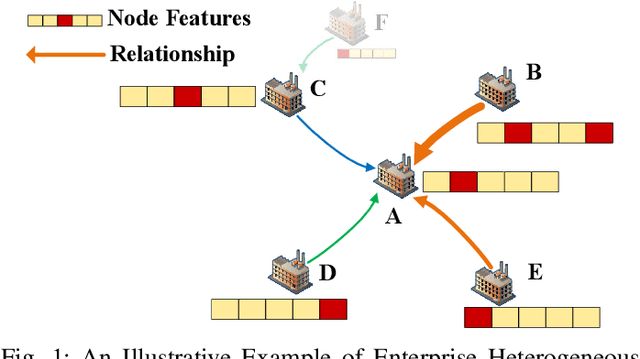
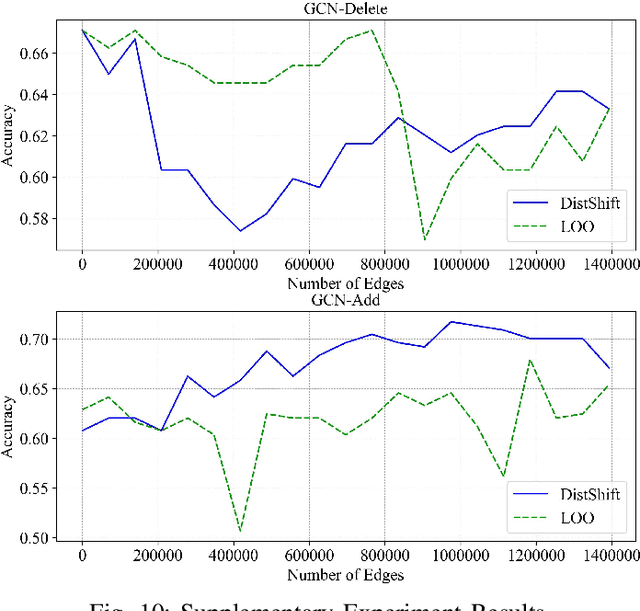

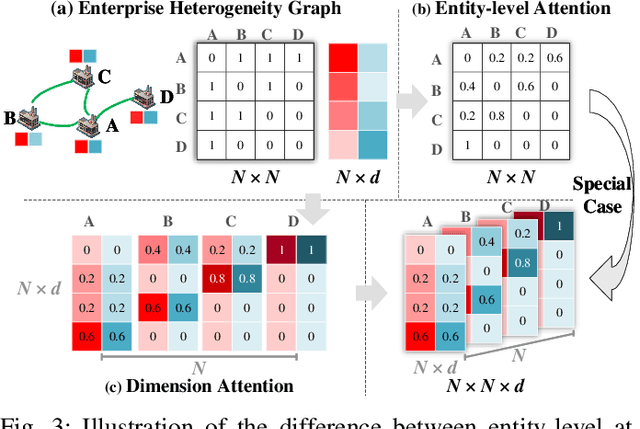
Abstract:Enterprise credit assessment is critical for evaluating financial risk, and Graph Neural Networks (GNNs), with their advanced capability to model inter-entity relationships, are a natural tool to get a deeper understanding of these financial networks. However, existing GNN-based methodologies predominantly emphasize entity-level attention mechanisms for contagion risk aggregation, often overlooking the heterogeneous importance of different feature dimensions, thus falling short in adequately modeling credit risk levels. To address this issue, we propose a novel architecture named Graph Dimension Attention Network (GDAN), which incorporates a dimension-level attention mechanism to capture fine-grained risk-related characteristics. Furthermore, we explore the interpretability of the GNN-based method in financial scenarios and propose a simple but effective data-centric explainer for GDAN, called GDAN-DistShift. DistShift provides edge-level interpretability by quantifying distribution shifts during the message-passing process. Moreover, we collected a real-world, multi-source Enterprise Credit Assessment Dataset (ECAD) and have made it accessible to the research community since high-quality datasets are lacking in this field. Extensive experiments conducted on ECAD demonstrate the effectiveness of our methods. In addition, we ran GDAN on the well-known datasets SMEsD and DBLP, also with excellent results.
Unified Dual-Intent Translation for Joint Modeling of Search and Recommendation
Jul 01, 2024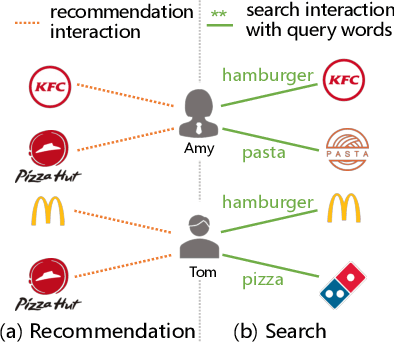
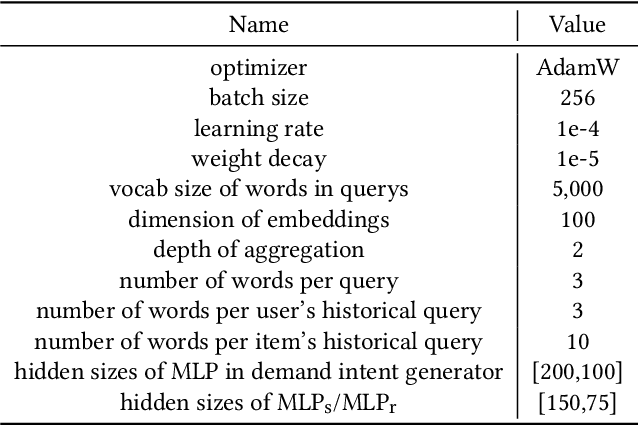
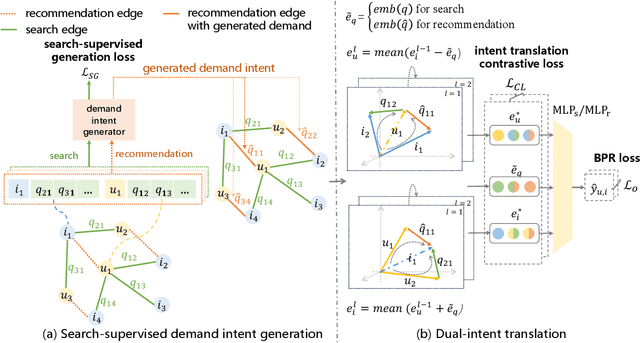
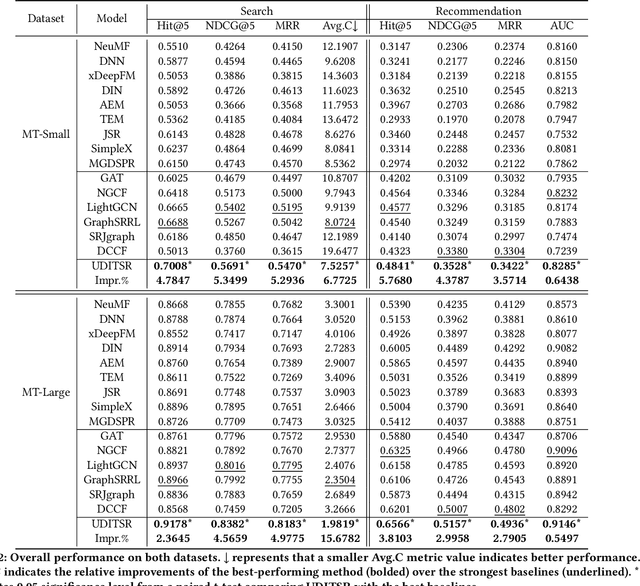
Abstract:Recommendation systems, which assist users in discovering their preferred items among numerous options, have served billions of users across various online platforms. Intuitively, users' interactions with items are highly driven by their unchanging inherent intents (e.g., always preferring high-quality items) and changing demand intents (e.g., wanting a T-shirt in summer but a down jacket in winter). However, both types of intents are implicitly expressed in recommendation scenario, posing challenges in leveraging them for accurate intent-aware recommendations. Fortunately, in search scenario, often found alongside recommendation on the same online platform, users express their demand intents explicitly through their query words. Intuitively, in both scenarios, a user shares the same inherent intent and the interactions may be influenced by the same demand intent. It is therefore feasible to utilize the interaction data from both scenarios to reinforce the dual intents for joint intent-aware modeling. But the joint modeling should deal with two problems: 1) accurately modeling users' implicit demand intents in recommendation; 2) modeling the relation between the dual intents and the interactive items. To address these problems, we propose a novel model named Unified Dual-Intents Translation for joint modeling of Search and Recommendation (UDITSR). To accurately simulate users' demand intents in recommendation, we utilize real queries from search data as supervision information to guide its generation. To explicitly model the relation among the triplet <inherent intent, demand intent, interactive item>, we propose a dual-intent translation propagation mechanism to learn the triplet in the same semantic space via embedding translations. Extensive experiments demonstrate that UDITSR outperforms SOTA baselines both in search and recommendation tasks.
Job-SDF: A Multi-Granularity Dataset for Job Skill Demand Forecasting and Benchmarking
Jun 17, 2024Abstract:In a rapidly evolving job market, skill demand forecasting is crucial as it enables policymakers and businesses to anticipate and adapt to changes, ensuring that workforce skills align with market needs, thereby enhancing productivity and competitiveness. Additionally, by identifying emerging skill requirements, it directs individuals towards relevant training and education opportunities, promoting continuous self-learning and development. However, the absence of comprehensive datasets presents a significant challenge, impeding research and the advancement of this field. To bridge this gap, we present Job-SDF, a dataset designed to train and benchmark job-skill demand forecasting models. Based on 10.35 million public job advertisements collected from major online recruitment platforms in China between 2021 and 2023, this dataset encompasses monthly recruitment demand for 2,324 types of skills across 521 companies. Our dataset uniquely enables evaluating skill demand forecasting models at various granularities, including occupation, company, and regional levels. We benchmark a range of models on this dataset, evaluating their performance in standard scenarios, in predictions focused on lower value ranges, and in the presence of structural breaks, providing new insights for further research. Our code and dataset are publicly accessible via the https://github.com/Job-SDF/benchmark.
DFGNN: Dual-frequency Graph Neural Network for Sign-aware Feedback
May 24, 2024Abstract:The graph-based recommendation has achieved great success in recent years. However, most existing graph-based recommendations focus on capturing user preference based on positive edges/feedback, while ignoring negative edges/feedback (e.g., dislike, low rating) that widely exist in real-world recommender systems. How to utilize negative feedback in graph-based recommendations still remains underexplored. In this study, we first conducted a comprehensive experimental analysis and found that (1) existing graph neural networks are not well-suited for modeling negative feedback, which acts as a high-frequency signal in a user-item graph. (2) The graph-based recommendation suffers from the representation degeneration problem. Based on the two observations, we propose a novel model that models positive and negative feedback from a frequency filter perspective called Dual-frequency Graph Neural Network for Sign-aware Recommendation (DFGNN). Specifically, in DFGNN, the designed dual-frequency graph filter (DGF) captures both low-frequency and high-frequency signals that contain positive and negative feedback. Furthermore, the proposed signed graph regularization is applied to maintain the user/item embedding uniform in the embedding space to alleviate the representation degeneration problem. Additionally, we conduct extensive experiments on real-world datasets and demonstrate the effectiveness of the proposed model. Codes of our model will be released upon acceptance.
 Add to Chrome
Add to Chrome Add to Firefox
Add to Firefox Add to Edge
Add to Edge